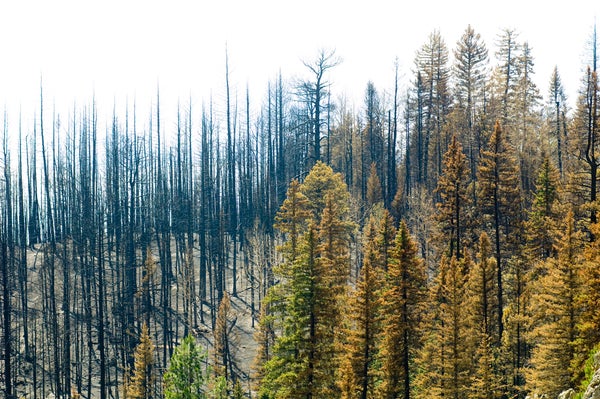This article was published in Scientific American’s former blog network and reflects the views of the author, not necessarily those of Scientific American
“In just one day,” she told me, “it burned everything away.”
Nina Wells, a retired Environmental Specialist with the New Mexico Environment Department Surface Water Quality Bureau, has over 20 years of experience coping with fires and drought. She was describing the Las Conchas fire, the catastrophic flames that burned nearly an acre per second for 13 hours in 2011, ultimately igniting more than 150,000 acres and threatening the town of Los Alamos.
Today, Nina is a board member of Los Amigos de Valles Caldera, a small organization trying to get out front of climate change in the region.
On supporting science journalism
If you're enjoying this article, consider supporting our award-winning journalism by subscribing. By purchasing a subscription you are helping to ensure the future of impactful stories about the discoveries and ideas shaping our world today.
When I consider the future of the warming world, getting caught in a fire is the plausible reality that worries me the most. Come summer in Montana, I expect to smell the smoke from my front porch. When I lived in California, I regularly monitored the fire status online, studying the maps and watching the red dots advance across the state. Whereas retreating glaciers were once the iconic imagery that raised awareness of “global warming,” the stories of fire are now the ones inciting fear.
Journalist David Wallace-Wells argues that people need to panic. I think what we need is to work both individually and collectively in calculated ways—with a greater sense of urgency—to cope with the range of impacts occurring.
Whether it’s drought or fires, inundation or erosion, what happens at the local scale matters. That’s where the impacts affect individual lives. That’s where what people do in their communities can help us cope with the consequences of a warming world.
“Adaptation is what we have left,” Nina said.
“How are we handling fire?” I asked Liz Tully, my colleague at the Wildlife Conservation Society and the associate director of the Climate Adaptation Fund. We were discussing the projects we’ve supported and my interest in talking to the individuals leading local adaptation efforts across the United States. These people aren’t stuck pondering, “What can I do?” They’re already doing. They’re confronting flames and floods, coasts slipping into the sea, fleeting fresh water, and risk for disease spreading in a warming world.
In many places affected by fire, the dramatic changes to the landscape lead to an increased risk of flooding. In the wake of the Soberanes fire in California, I remember crossing the a bridge in Big Sur, just days before a landslide rendered it useless. To me, fire and flooding together seem so unwieldy—and the consequences so grave—that I could only assume the people trying to adapt to those impacts are models of what we need more of today. What are they doing differently to respond to the threats? That’s what I wanted to know.
“We’ve started the clock,” Nina told me, referring to the lag time between increased emissions and impacts. Like many of the other people I interviewed who are tackling local adaptation projects, she says the work begins in our communities, with the people who will appreciate the risks at hand and the value of responding to the local consequences of the global problem. “I could have moved to other places, but this is home. There’s also a history of adaptation with other cultures adjusting their way of life to tough conditions in the past. You gotta try.”
In response to the fires, Los Amigos, in partnership with a team of local resource managers, researchers and innovative ecologists, tried to get out front of the anticipated flooding in New Mexico by using what’s called the “plug-and-pond” approach to restoration. The work involves plugging up the gullied and eroded landscape with native soil, creating a wetland area more resistant to extreme temperatures and fire, redistributing groundwater, and preventing heavy postfire flooding.
In 2018, 35 plug-and-pond sites were constructed in Valles Caldera. Brent Newman, a scientist with the Los Alamos National Laboratory, says the technique is underrated and still underutilized. His research has shown the effort improves postfire water quality and helps keep water on the landscape longer throughout the summer, further helping to moderate temperatures and groundwater flow.
“Is it scalable? Could it be implemented elsewhere?” I asked Steve Vrooman, an ecologist with Keystone Restoration Ecology, in Santa Fe, a restoration design and construction firm that has led design and implementation efforts.
“Yes, with any degraded landscape, particularly in response to fire and drought in the West,” he replied. “We’re doing a lot of work to mitigate fires and thin,” he continued, “but we don’t have a technique in place to address the floods.” He was referring to agency responses, to the Burned Area Emergency Response program and other federal initiatives. “It all seems so big and scary. But if we did this work beforehand or had a design for postfire watershed restoration to implement after firefighting, we could prevent a lot of damage.”
Noting that the challenge will likely only intensify in the future, I was curious to know what motivates Steve.
“I’ve seen such a positive response from the landscape,” he answered. “Water is flowing. Ponds are full. Areas are getting wet. With new remote sensing technology like lidar, we can assess thousands of acres in a day. We’re learning how to do this work on bigger and bigger areas. Scaling up—that’s what keeps me going.”
Don’t get me wrong; curtailing emissions remains critical. But as the consequences of what we’ve already released continue to unfold, we will all need to find ways of coping in our communities.
This is the second in a series of posts on adapting to climate change. You can see the previous post, Adapting to Climate Change in Alaska, here.
